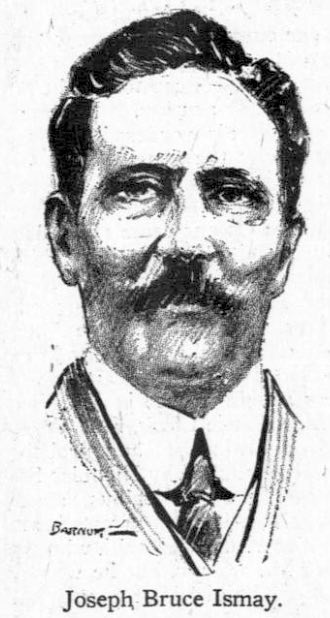
Ismay, the controlling builder of the Titanic, will forever be known as a coward. While on the maiden voyage (and only voyage) of the Titanic, he was one of the first to rush out to get on a lifeboat when the Titanic hit the iceberg. Below is an account of that fatal night by the fifth officer of the ship.

Ismay Was “Very Excited” and “Anxious to Get Off the Titanic,” Says Ship’s Fifth Officer
Washington, April 24. — J. Bruce Ismay, multimillionaire and managing director of the White Star line, was ordered by one of his own employees to —
“Get the Hell out of that!”
Mr. Ismay suffered this painful experience as the Titanic was sinking beneath the waters of the Atlantic, and he, Ismay, was trying to find a place for himself in the lifeboats.
The employee who thus rudely addressed the millionaire owner who was “saved with the women and children” was Harold J. Lowe, fifth officer of the Titanic.
Lowe was much embarrassed in telling of his speech to Ismay before the Senate Investigation Committee today. He could not be induced to speak the words he used.
Ismay, it appears, was about the busiest person aboard the Titanic after the collision with the iceberg.
Lowe was loading boat No. 5 with women and children. Ismay appeared on the scene, and began to take charge of Lowe’s work, saying who should and who should not enter the lifeboat, and where those who did get in should sit.
The millionaire was “very much excited,” and “seemed very anxious to get off the Titanic,” according to Lowe.
“I didn’t know who he was, and I used some strong language,” explained Lowe. “It was in that heat of the moment, sir.”
“What was the language?” inquired Senator Smith, intensely curious.
“I don’t like to say,” said Lowe.
“But the committee wants to hear it,” said Smith.
Lowe flushed and glanced around the room, his gaze falling nervously on Ismay, who sat with his head bowed. There were many women present.
“I’ll write it,” he said, and did so.
There was nothing of great importance brought out by Lowe’s testimony.
Major Peuchen, millionaire yachtsman of Canada, yesterday told the committee that the crew of the Titanic was such as no great liner should have put to sea with.
Peuchen said many of the crew were not trained seamen, and that they never had worked together before the Titanic drew out of Southampton.
It was to this fact that Peuchen laid the undermanning of the lifeboats, and the fact that a number of the sailors in the boats could not row.
Senator Smith asked Lowe about these things.
“That none of the crew could row is easily explained. A sailor is not necessarily a boatman. There is a wide difference. A sailor may sail the seas for years and never touch an oar.”
When it came to a question of the sufficiency of the Titanic’s crew of 800, Lowe was evasive.
It was only after long cross examination by Smith that the fifth officer admitted that there were not enough sailors on the boat deck to man the boats.
“We did the best we could,” he said. “Many of the men were below decks, clearing the gangway doors. We did not have enough men, but it was not our fault.”
Lowe also gave an explanation of the lifeboats not being filled to capacity with passengers before being loaded.
“The danger is,” he said, “that if you overload a boat it may buckle up from both ends. There is no support in the center. I should not want to put more than fifty in a boat before she was lowered. She might, nevertheless, carry more than sixty safely if loaded from the water.”
Senator Smith and Lowe constantly quibbled over questions and answers.
Both often became sarcastic, often angry.
“You could say ‘Go to h—!’ to Mr. Ismay, why can’t you answer my questions?” asked Smith.
“I do answer them in my own best way — When I can understand them,” Lowe answered quietly.
“We put the women in the boats in the order in which they arrived at the boats. First come, first served. We asked no questions of women and children, but the men were ordered to stand back.
“When boat No. 5 was pretty well filled, Mr. Murdock said, ‘That will do,’ and we lowered the boat.
“Then we went to No. 3. Mr. Ismay was there again. When the first detonator went off, the flash lighted up the whole deck. I saw Ismay distinctly, standing beside me.
“After No. 3 was loaded we lowered it. Then I went to the emergency boat. I put 27 in that, including 5 women. Then we filled boats Nos. 14 and 16 on the port side. We put 58 in No. 14. They were all women except one Italian. He sneaked sneaked in dressed like a woman. He wore a shawl, and a woman’s hat. I did not see him until the last moment.”
At the beginning of his story, Lowe told how he ran away from home when he was fourteen years old, and served first for five years on the West Coast of Africa. He is 29 years old now.
Lowe declared it would have been suicide for any of the lifeboats to have gone immediately to the scene of the sinking of the Titanic after the giant ship disappeared.
“I went as soon as I could. I held off only long enough to be sure that my boat with its load of passengers would not be swamped. It would have been suicide to have gone before.”
Source: (1912, April 24). Ismay Was “Very Excited” and “Anxious to Get Off the Titanic,” Says Ship’s Fifth Officer. The Day Book.

